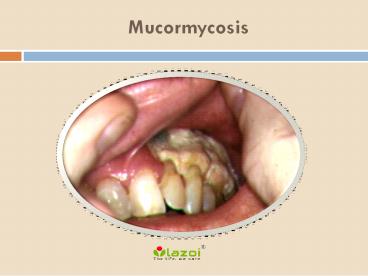Mucormycosis: Causes, Symptoms, Daignosis, Prevention and Treatment - PowerPoint PPT Presentation
Title:
Mucormycosis: Causes, Symptoms, Daignosis, Prevention and Treatment
Description:
Mucormycosis is a serious but rare fungal infectional disease that is caused by a group of molds known as mucormycetes. – PowerPoint PPT presentation
Number of Views:1161
Title: Mucormycosis: Causes, Symptoms, Daignosis, Prevention and Treatment
1
Mucormycosis
2
Mucormycosis
- Mucormycosis is a serious but rare fungal
infection which is caused by a cluster of molds
called mucormycetes. These fungi tend to grow
within the environment, specifically in soil and
in link with decaying organic matter, like
leaves, compost piles, or rotten wood.Some of
the examples of the types of fungi that most
commonly cause mucormycosis are Rhizopus
species, Mucor species, Cunninghamella
bertholletiae, Apophysomyces species, and
Lichtheimia species.People suffer mucormycosis
by coming in contact with the fungal spores
present in the environment. For example, the lung
or sinus forms of the infection can happen to
someone after he or she inhales the spores from
the air.Usually these forms of mucormycosis
occur in people who have weakened immune systems.
Mucormycosis can be produced on the skin as the
fungus makes its way and enters the skin via cut,
scrape, burn, or other type of skin trauma.
3
How does someone get mucormycosis?
- People get mucormycosis by coming in contact
with fungal spores in the environment. For
example, the sinus or lung types of the infection
can happen after someone inhales the spores
present in the air. Mucormycosis can develop on
the skin after the fungus enters the skin through
a cut, scrape, burn, or other type of skin
trauma.
4
How is mucormycosis diagnosed?
- Doctor looks at your previous medical history,
symptoms, physical examinations, and laboratory
tests when diagnosing mucormycosis.If your
doctor founds that you have mucormycosis in your
lungs or sinuses, he or she might collect a
sample of fluid from your respiratory system to
send to a laboratory.Your doctor may perform a
tissue biopsy, in which a small sample of
affected tissue is analyzed in a laboratory for
evidence of mucormycosis under a microscope or in
a fungal culture.You may also need to go
through imaging tests like a CT scan of your
lungs, sinuses, or other parts of your body
depending on the location of the suspected
infection.
5
Symptoms of Mucormycosis
- The symptoms of mucormycosis rely on where in
the body the fungus is growing. Mucormycosis is
very rare and it typically affects people who
have weakened immune systems. Contact your doctor
if you have symptoms that you think are related
to mucormycosis.Symptoms of mucormycosis
include - One-sided facial swelling
- Headache
- Nasal or sinus congestion
- Black lesions on upper inside of mouth
- Fever
- Cough
6
Symptoms of Mucormycosis
Continue
- Chest pain
- Shortness of breath
- Abdominal pain
- Nausea and vomiting
- Gastrointestinal bleeding
7
How is mucormycosis treated?
- Mucormycosis is a severe infection and it needs
to be treated with prescribed antifungal
medication, generally amphotericin B,
posaconazole or isavuconazole.These medications
are given through a vein (amphotericin B,
posaconazole, isavuconazole) or by mouth
(posaconazole, isavuconazole). Often,
mucormycosis requires surgery to cut away the
infected tissue.
8
CONNECT WITH US
- Logon to
- www.lazoi.com
- Like us on Facebook
- https//www.facebook.com/LazoiTheLife
- Follow us on Twitter
- https//www.twitter.com/lazoithelife
- Follow us on Pinterest
- https//www.in.pinterest.com/lazoithelife































